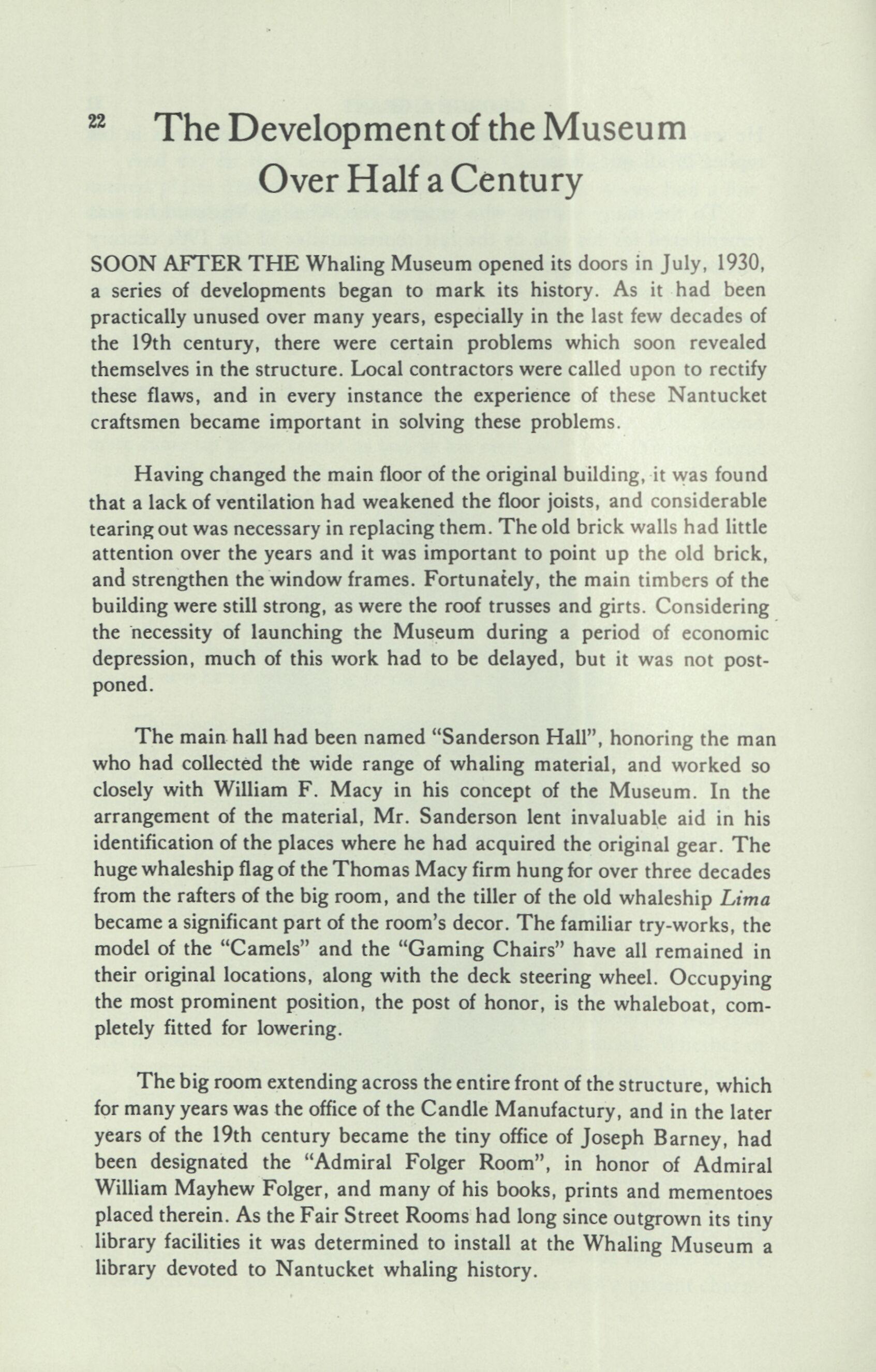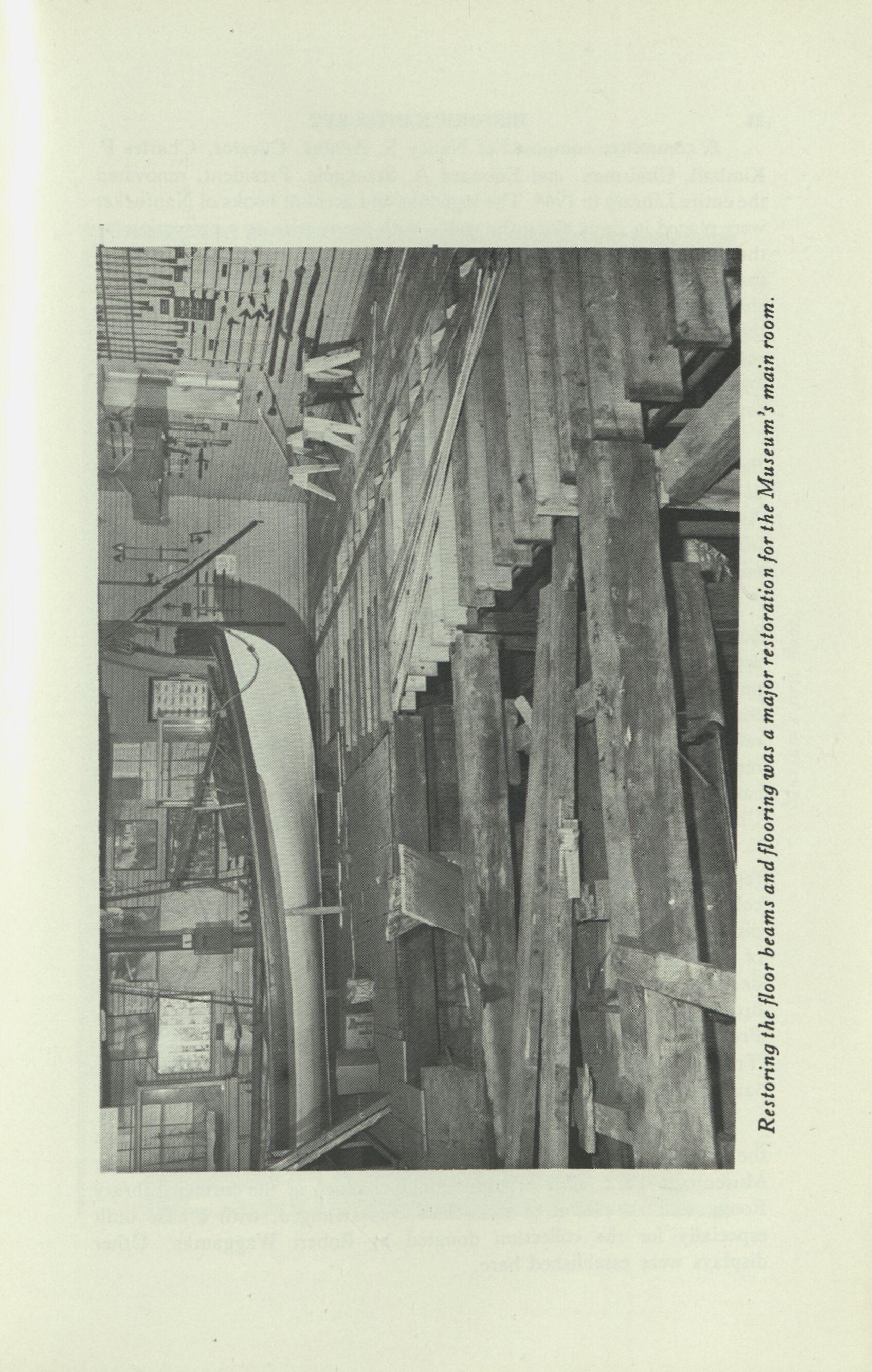
9 minute read
The Development of the Museum Over Half a Century
22 The Development of the Museum Over Half a Century
SOON AFTER THE Whaling Museum opened its doors in July, 1930, a series of developments began to mark its history. As it had been practically unused over many years, especially in the last few decades of the 19th century, there were certain problems which soon revealed themselves in the structure. Local contractors were called upon to rectify these flaws, and in every instance the experience of these Nantucket craftsmen became important in solving these problems.
Having changed the main floor of the original building, it was found that a lack of ventilation had weakened the floor joists, and considerable tearing out was necessary in replacing them. The old brick walls had little attention over the years and it was important to point up the old brick, and strengthen the window frames. Fortunately, the main timbers of the building were still strong, as were the roof trusses and girts. Considering the necessity of launching the Museum during a period of economic depression, much of this work had to be delayed, but it was not postponed.
The main hall had been named "Sanderson Hall", honoring the man who had collected the wide range of whaling material, and worked so closely with William F. Macy in his concept of the Museum. In the arrangement of the material, Mr. Sanderson lent invaluable aid in his identification of the places where he had acquired the original gear. The huge whaleship flag of the Thomas Macy firm hung for over three decades from the rafters of the big room, and the tiller of the old whaleship Lima became a significant part of the room's decor. The familiar try-works, the model of the "Camels" and the "Gaming Chairs" have all remained in their original locations, along with the deck steering wheel. Occupying the most prominent position, the post of honor, is the whaleboat, completely fitted for lowering.
The big room extending across the entire front of the structure, which for many years was the office of the Candle Manufactury, and in the later years of the 19th century became the tiny office of Joseph Barney, had been designated the "Admiral Folger Room", in honor of Admiral William Mayhew Folger, and many of his books, prints and mementoes placed therein. As the Fair Street Rooms had long since outgrown its tiny library facilities it was determined to install at the Whaling Museum a library devoted to Nantucket whaling history.

24 HISTORIC NANTUCKET
A committee composed of Nancy S. Adams, Curator, Charles P. Kimball, Chairman, and Edouard A. Stackpole, President, renovated the entire Library in 1944. The logbooks and account books of Nantucket were placed in cases along the walls, with heavy wire as a protection for the framed doors and to provide circulation of air. Books of various categories in maritime history were selected for other shelves. Portraits of shipmasters and shipowners, together with other appointments, enhanced the attractiveness of the room. Tables for visitors who wished to read or rest were installed with comfortable chairs. Several years later all the logbooks were microfilmed, and readers provided for the use of these copies.
In 1949 the placement of the original lighthouse lens assembly from the Sankaty Lighthouse was accomplished, with Sanderson Hall selected as the temporary location. The story of the Nantucket Historical Association's acquisition of the lens is an interesting one, and the man who accomplished it has promised to write the story for Historic Nantucket for a future issue.
Two exhibit rooms on either side of the main corridor have proven quite popular over the years. The South Seas room has many unusual artifacts from several Pacific island groups, including ceremonial clubs, paddles and spears. The model of a Maori canoe is outstanding. During the regime of Hugh Chace as Chairman, this room was completely refurbished and improved. Opposite is the Portrait Room, with the remarkable array of portraits of Nantucket whaling masters and, in one case, the wife of the shipmaster occupies an equally prominent position. Chairman Renny Stackpole has recently renovated the display.
The large attic of the Whaling Museum had been used as a storage repository for material from the beginning of its career. In 1943, its collections were surveyed, additional material brought in and, under the direction of the Chairman, William E. Gardner, it became the "Archives" of the Association. For the next decade this proved to be an important decision but with the 1970's it was found that the quantity of material brought a problem in proper maintenance. Under the direction of President George W. Jones and Administrator (later President) Leroy H. True, a campaign to salvage the important historical material was launched with highly satisfactory results obtained.

With the advent of the Peter Foulger Museum the entire Library of the N. H. A. was removed from the Whaling Museum to the new Museum in 1972. This brought about changes in the former Library Room, and an exhibit of scrimshaw was arranged, with a case built especially for the collection donated by Robert Waggaman. Other displays were established here.

26 HISTORIC NANTUCKET
One of the most energetic of the Chairmen presiding over the Whaling Museum was W. Ripley Nelson, a Vice President and Council member of long standing. It was Mr. Nelson who brought about remarkable additions to the displays with his installation of what he termed as "Craft Shops" in the basement of the structure. With the aid of Archibald Cartwright, the Custodian at that time, Mr. Nelson incorporated here the Rigging Loft, Sail-Loft, Boat-builders' Shop, Shipsmith's Shop, and Cooper Shop. These were called "Whale Craft Shops", and made valuable additions to the Museum's displays. They add authentic touches to the Whaling Museum and serve as reminders to Chairman Nelson's thoughtfulness and enterprise.
In this same year (1958) the reception room, now the sales area, was renovated. A most unusual addition to the displays came in the form of inner and outer iron vault doors, dating back to 1839. These were originally installed for the Merchants & Mechanics Bank, which stood on the corner of Main and Federal streets, and was destroyed by the Fire of 1846. They were taken from the ruins and placed in the Joseph B. Macy warehouse on Straight Wharf, now the Kenneth Taylor Gallery, where they remained until acquired by the Nantucket Historical Association. The three keys necessary to unlock thevault doors hang on the wall close by.

One of the most attractive rooms is that facing the reception lobby the Scrimshaw Room. Here may be found some of the outstanding examples of that extraordinary art form first introduced by the American whalemen bearing the mysterious name of "Scrimshaw". Here we find the most popular of these carvings and etchings. Those utilitarian articles, called jagging or crimping wheels, bodkins, swifts, rolling pins, bird cages, clothes pins, sewing boxes, work boxes, and other articles made for the folks at home by the whaleman at sea are on display here. Of great interest arethose especial treasures - the sperm whales' teeth with incisings and engravings which are the most graphic of scrimshaw art.
The addition of the "Whale Room" in 1969 helped bring the Museum into a complete whaling center. Through the financial support of the Nantucket Historical Trust, led by Walter Beinecke, Jr., the skeleton of a finback whale -- which came up on the beach at Dionis in 1967 - was salvaged and with professional skill re-assembled and placed on exhibit in a new building also erected by the Trust. This, with exhibits describing the story, and other displays, including a handsome diorama made by Raymond de Lucia, donated in memory of Austin Tyrer, of Nantucket, make most unusual additions to the room.
The custodians of the Whaling Museum, who have presided over the important affairs of this invaluable institution, following in the wake of
28 HISTORIC NANTUCKET
George A. Grant, have been: Wallace Long, who sailed in windjammers throughout the Western Ocean, a World War I veteran, and a man possessing a remarkable knowledge of schooners in the coastwise trade, who served from 1942 to 1955; Archibald Cartwright, a veteran of a voyage on the whaler Sunbeam in 1902, a descendant of whalemen, a carpenter-contractor, and the retired Chief of the Nantucket Fire Department, who served from 1955 through 1962; James Everett Chapel, a fisherman and Life Saving Station veteran of many years; John Kittila, another Island resident who had been a Coast Guardsman in several stations; with assistants being Earle S. Weatherbee and Bertram Morris, who aided the Custodians in a number of capacities. Then came Captain Leland Topham, whose years as a Coast Guardsman on Nantucket and experience as a fisherman gave him an unusual background, and Clarence Swift, for thirteen years known as "the man who gives the talks", who had a regular following each season. Walter Lindquist served for fourteen years as the Manager-Custodian at the Museum, and was succeeded by the Rev. Frank Pattison, now on duty.
The Chairmen of the Whaling Museum Committee over the years have been invaluable in the time and planning they have contributed. To each of them the Association is indebted for carrying on the purposes for which it was established. William F. Macy was the first official Chairman of the Whaling Museum Committee, while also the President of the Association. At his death in 1935, Fred V. Fuller, a close friend, was appointed Chairman, holding the post for a year. In 1936, Charles P. Kimball accepted the post and continued until 1941, when he relinquished the Chairmanship, and the Rev. William E. Gardner agreed to take up the post, which he held until 1951. During the next year Howard U. Chase served as Chairman, resigning when he moved to Florida. At this point. W. Ripley Nelson, one of the Vice Presidents of the Association, was appointed Chairman and for the next twenty years (1952-1972) he became the active and efficient leader in the Whaling Museum's activities. At Mr. Nelson's death, the Association was fortunate in obtaining the services of Hugh W. Chace as Chairman, and he continued in this position until 1979, when he found it necessary to decline re-appointment, and was succeeded by Renny A. Stackpole, the present Chairman.

It would require a volume to recount the experiences of a veritable corps of faithful attendants at the Whaling Museum over the fifty years of its history. These faithful workers include a long listing of both men and women, many retired from active roles, who have found their new duties at the Museum rewarding and stimulating. With the initial opening of the 1930 season, Custodian Grant was often alone, although Mr. Macy came









